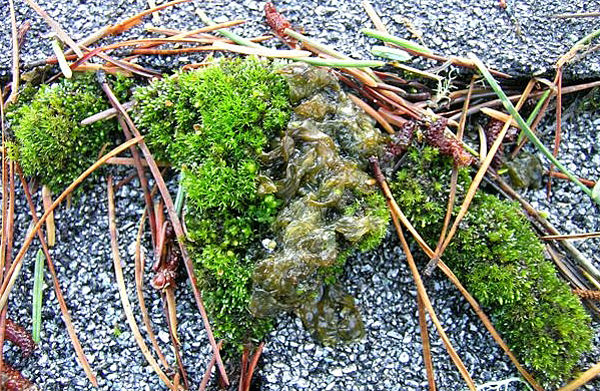Roof residents, or where green is not necessarily good
Published 5:00 pm Monday, April 1, 2013

- <p>Two species of moss share space on an asphalt roof with a brown-black cyanobacteria, Nostoc commune. The mosses are seen year round; this bacteria appears in late fall on suitable roofs.</p>
Several species arrive quickly on suitable roofs, starting with algae and bacteria. Algae are tiny plants that are so small and light that their spores blow through the air. These come in several colors, including green, red, orange and golden brown, and also live on trees. Black stains on asphalt shingle roofs are usually photosynthetic bacteria, as are olive brown globs and bubbles that can make the roof appear to be buried in gelatinous slime.
Lichens and mosses soon follow, and are also tree inhabitants. Lichens may be inconspicuous for a couple of years before they are big enough to form more than a thin gray or black film, but mosses go from thin green films to tidy clumps in one year. The moment mosses form moisture-holding tufts of green, gray, gold and silver, worms and other invertebrates arrive to live under them. Have you ever seen a crow walking a gutter or a roof, turning over moss clumps? That crow is hunting for juicy protein-rich worms. Tiny beetles, other insects, springtails, millipedes, tardigrades, isopods and other tiny animals also live in the mosses, and yes, these species also live on trees.
Roof occupancy does not stop at algae, lichens and mosses, and invertebrates. As leaf litter builds, humus forms on roofs and in gutters, and ferns and plants with seeds that float in the air show up. On well-mossed roofs Ive seen massive clumps of licorice fern (Polypodium glycrrhiza), along with willowherbs, cats-ear and dandelion. These plants all have seeds or spores that float on the air, so its no surprise that they are easily lofted to a roof. Sitka spruce and red alder have seeds with small wings that blow on the wind, as I realized the year I pulled five spruce seedlings from a gutter full of compost. In my defense, Id sprained an ankle the prior summer, and did not climb ladders for more than a year. That was all it took to fill the gutters with conifer needles, for those needles to form compost, and for spruce seeds to arrive and germinate.
For heavier seeds, there are birds to carry seeds; they eat the fruits and poop the seeds out high in trees, on favorite perches by birdbaths, and on roofs. On a well-thatched roof, thick with natural leaf litter and mosses, grow holly, ivy, blackberry, elderberry, black currant, trailing currant, salmonberry, thimbleberry and twinberry, to name just a few local species that often end up on poorly tended roofs.
Why cleaning is necessary
Mosses have small proto-roots that exude weak acids to eat into bark and help anchor the plant. These same acids eat into and through asphalt and wood shingle roofs, which unlike trees dont keep growing new surfaces under the bark. The roof dissolution process takes years; eventually, the shingle is riddled with holes. Now, when it rains, the water drains into the building instead of down the roof to the gutters. Wood fungi, termites and carpenter ants take up occupancy in the damp wood under the roof. At that point, your house is toast, unless you replace the roof and rebuild damaged structural elements.
Birds dont help, either. Where birds like to congregate, bird poop falls, and this feeds plants. A favorite roof-roost for pigeons, for example, will grow impressive moss and lichen patches down slope from the roost. Bird poop is corrosive, and will help roofing material surfaces to break down quickly. There are many devices to keep birds from settling on roofs: Rows of ridgetop spikes and spines; rolls of spiky-spiny wire; long flexible wire spines to go between standing seams on metal roofs; bird-scarers, like large plastic owls; and whirly-gigs with bright reflective sections.
The simplest way to reduce these problems on roofs is to not let them start: Keep the roof clean; every year or two clean it off. Dont forget walls, window frames, decks and steps. These species arent fussy; theyll grow anywhere theres enough moisture, and too little disturbance. If you want your roof to last, mosses, leaf litter, and their companions have to go.
Some people clean during the dry season, others during the wet season. My father waited to clean gutters during the first rains each fall. As a child, I thought everyone cleaned gutters in the rain. I prefer midsummer myself, when the roof is dry and the air is warm. Some people put down copper or zinc flashing or spread zinc powder; these metal salts are toxic to mosses, lichens and algae. As metal salts wash down the roof, they kill the plants and fungi. Others wash roofs, and then during the dry season, spray on a layer of detergent. The detergent kills germinating spores and young plants of algae, lichens and mosses. It must be redone every two or three years. You still have to check gutters, downspouts, and subsurface storm drains, if you have these.
No matter which method you use, be safe. Set ladders properly on level firm ground. Have a safety spotter on the ground. Dont work on slippery wet roofs wait for dry weather. If you must be on a roof when its wet, use a safety harness. Wear sturdy boots with gripping soles. Put the cell phone aside until you are back on the ground. Your reward is a roof that may last for most of its planned design life, instead of being replaced decades too soon.
Kathleen Sayce, ecologist, lives on Willapa Bay north of Nahcotta and writes on a variety of topics about natural history of this area.




